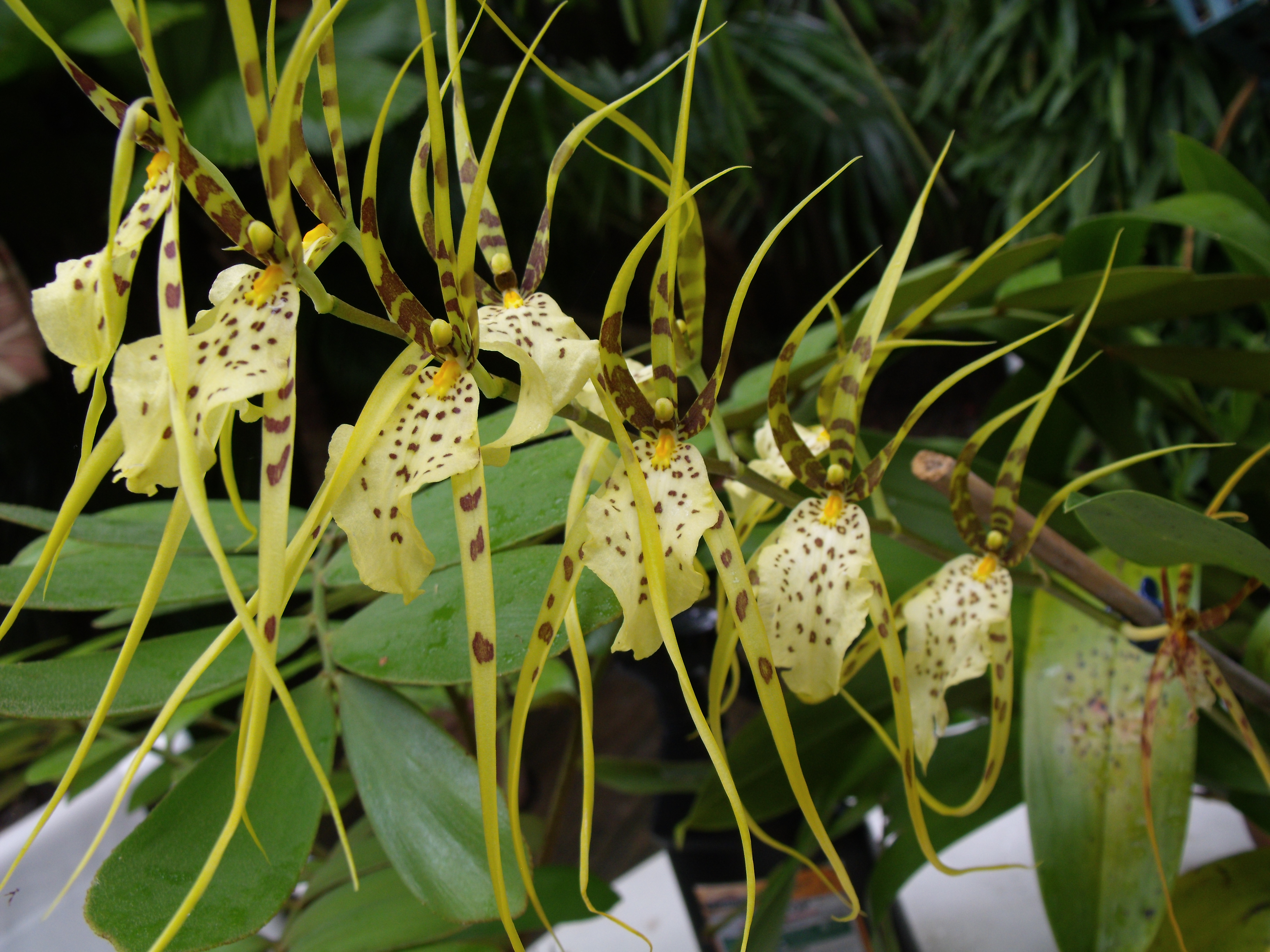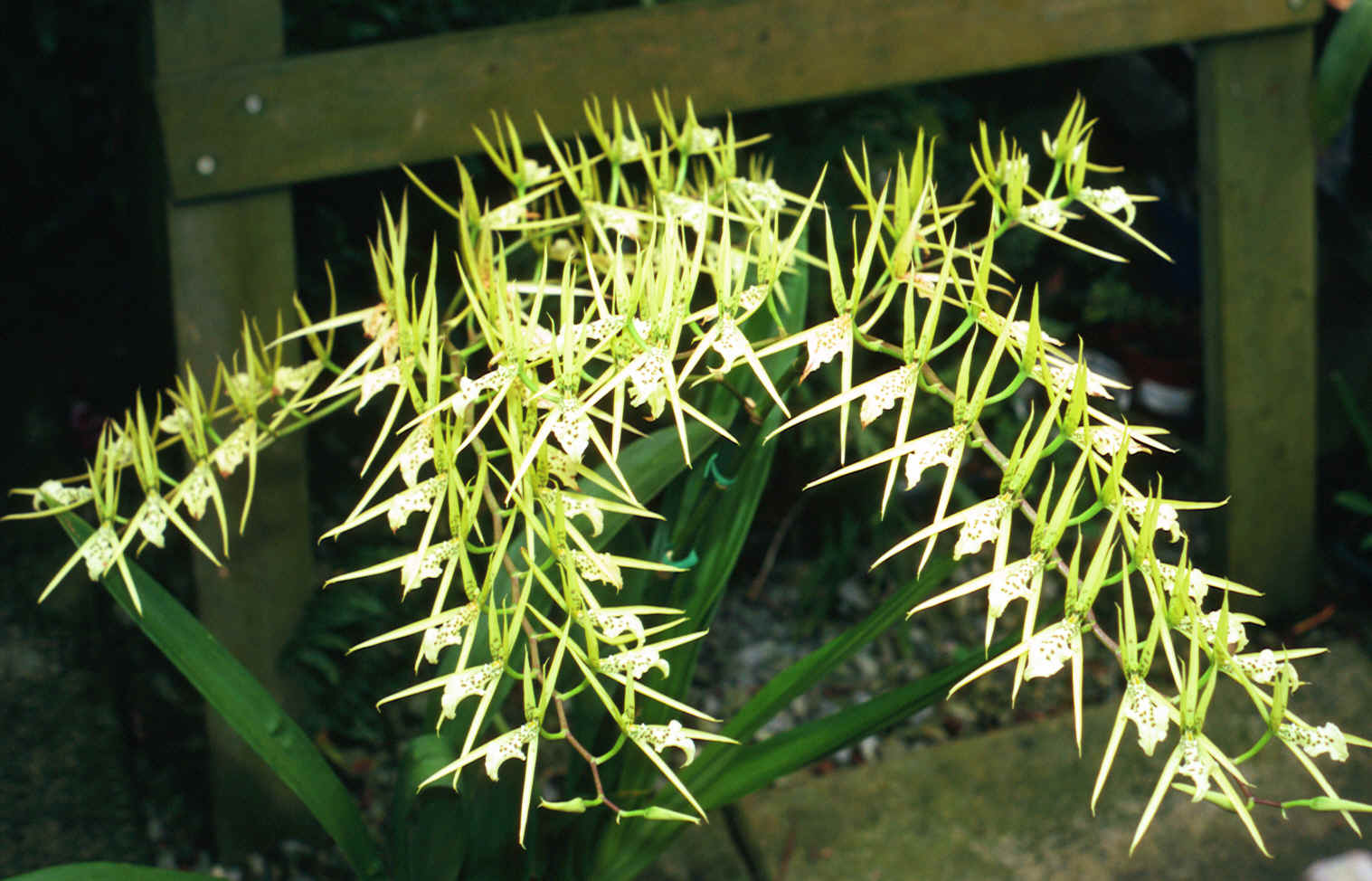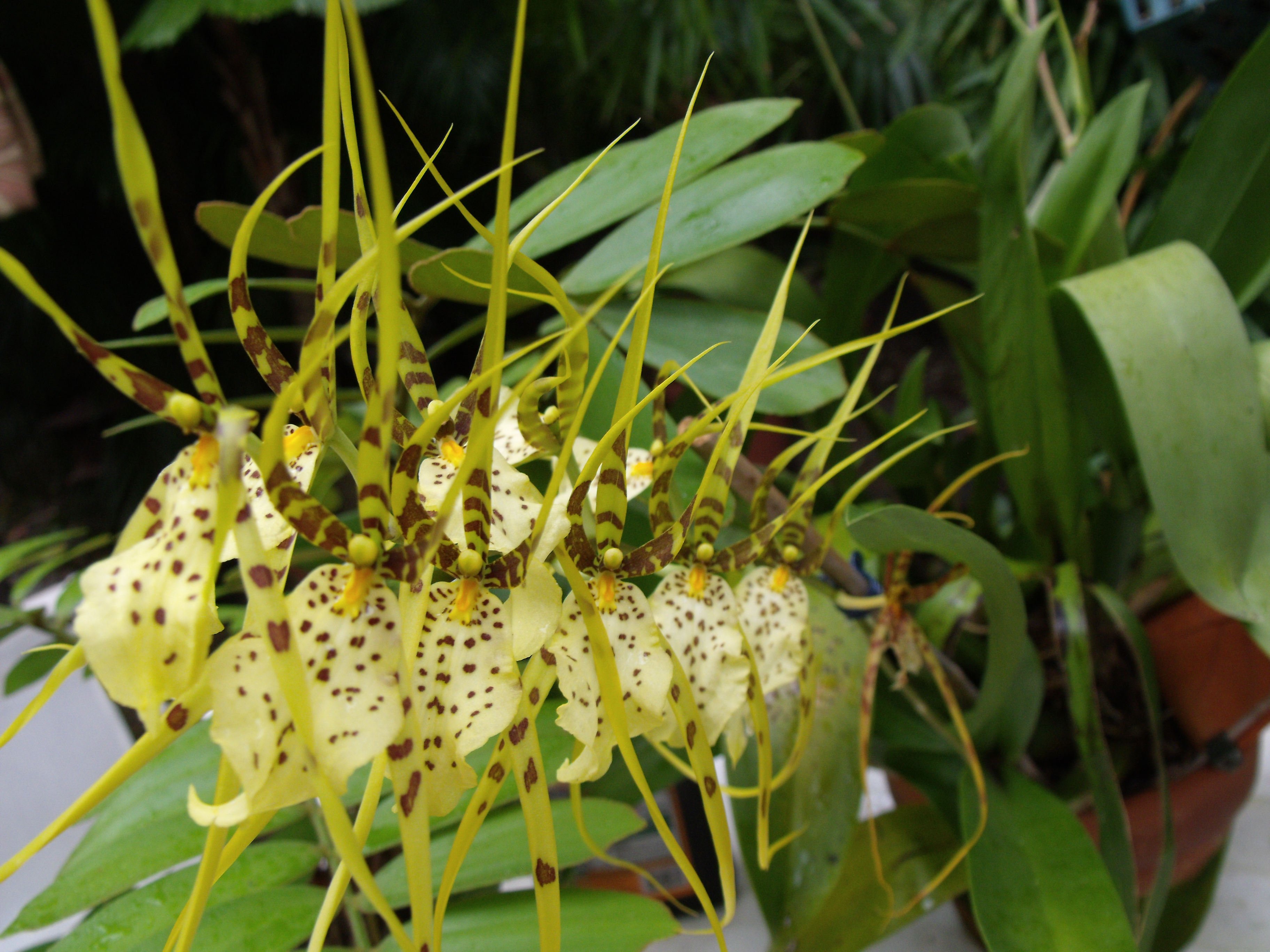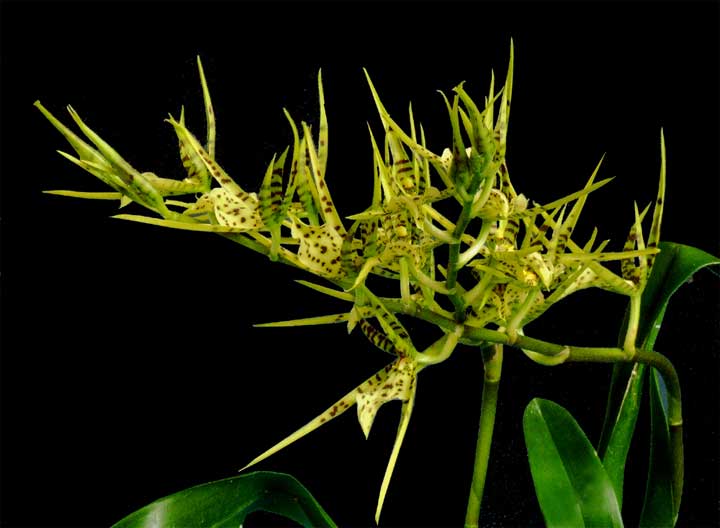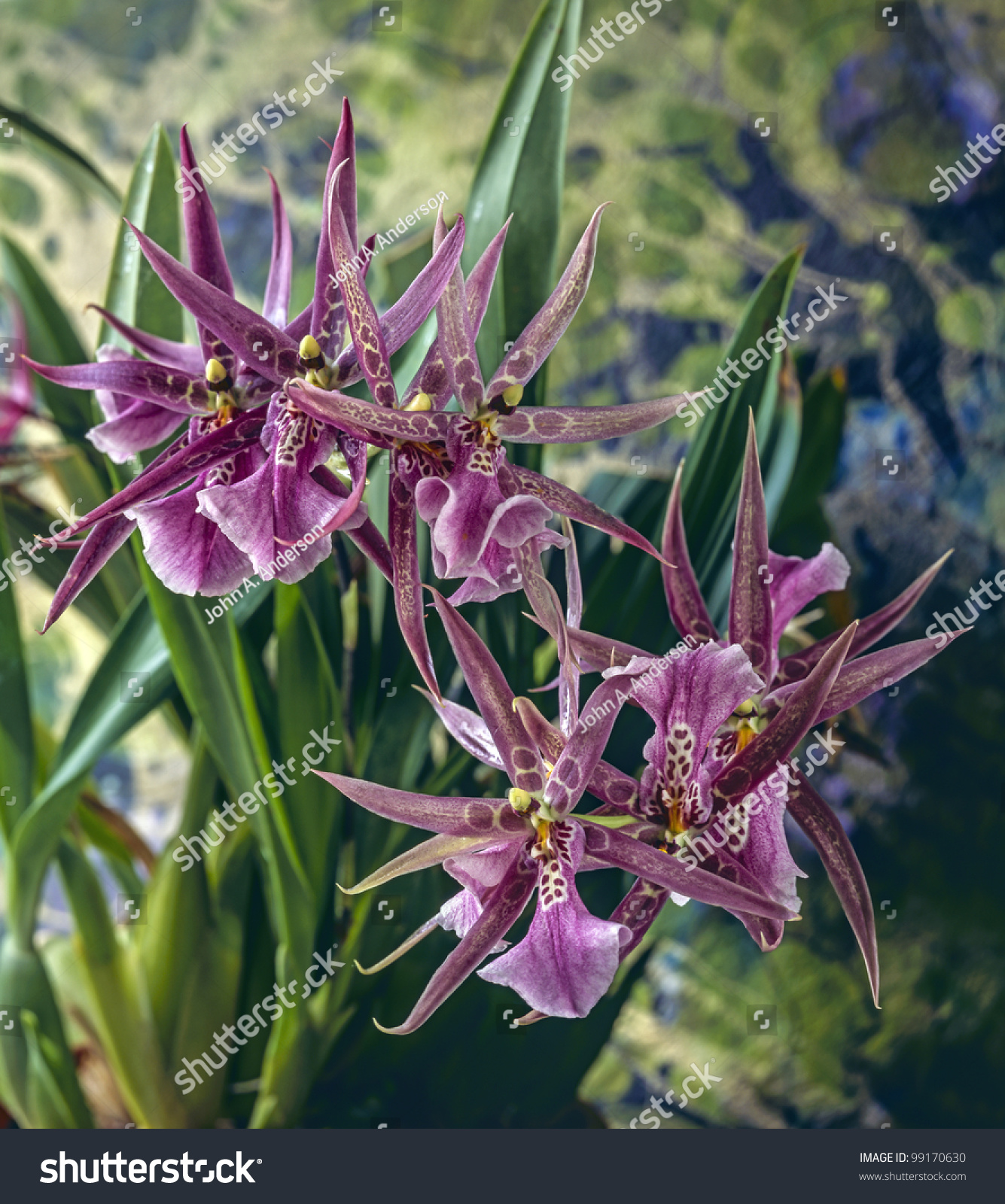Brassia
Brassia verrucosa
The genus Brassia from the orchid family (Orchidaceae) comprises 34 species, all native to tropical America. The small, perennial plants grow as epiphytes. Some species are cultivated occasionally due to their large flowers.
Description
All species of this genus form of a creeping rhizome pseudobulbs. These are dense clump like each other or are separated by a long rhizome. They are oval and laterally compressed to a ridge on each side; they consist of a single internode. The pseudobulbs are surrounded by low- leaves, the uppermost leaves are formed leaf-like. At the top of the pseudobulbs sit each one to three leaves. The leaves are smooth and folded in the bud along the center. The leaf form is lanceolate, narrow at the base tapering, the tip is blunt.
The grape-like, very rarely anything branched inflorescence appears laterally from the base of the pseudobulbs. The resupinierten flowers are two lines on the inflorescence axis. The bracts are small. The three sepals are narrowly linear, often very long, and not fused together. The two outer petals are shaped similarly, but smaller, sometimes facing forward. The petals have a yellowish or greenish color with brown spots. The lip is oval, unlobed, pointed at the end. On the lip sits a double breasted callus, the two small denticles or cusps formed at the base. The column is short, straight and not winged. The two hard pollinia are connected via a short, wide stalks with a small holdfast ( Viscidium ).
Some Brassia species is known to be pollinated by Wegwespen ( Pompilidae ). Wasps of the genera Pepsis and Campsomeris, whose prey are spiders, are deceived by the appearance of the flowers and attack them. When trying to grab the flower and carry away, the wasp pollinia are attached, or even the body of the insect existing pollinia are placed on the scar.
Dissemination
The species of the genus Brassia come northwards to Mexico and Florida, they colonize the whole of Central America, the Caribbean and the northern half of South America. They grow there as epiphytes in moist forests from sea level to altitudes of 1500 meters.
System
Within the subfamily Epidendroideae the genus Brassia in the tribe Maxillarieae and there in the subtribe Oncidiinae is classified. A group of species to Brassia glumacea filed by Williams in 1972 in the genus Ada. Other closely related genera are Aspasia, Cischweinfia, Miltonia and Systeloglossum.
The following 34 species have been described in this genus:
- Brassia angustilabia Schltr. , Panama and Brazil.
- Brassia antherotes Rchb.f., Ecuador.
- Brassia arachnoidea Barb.Rodr. , Brazil.
- Brassia arcuigera Rchb.f., Costa Rica, Panama, Venezuela, Colombia and Ecuador to Peru.
- Brassia aurorae D.E.Benn. , Peru.
- Brassia bidens Lindl., Guyana, Venezuela and Brazil.
- Brassia boliviensis Schltr. , Bolivia.
- Brassia caudata (L.) Lindl., Large distribution area from South Florida via Central America and the Caribbean to the northern half of South America.
- Brassia cauliformis C.Schweinf. , Peru.
- Brassia chloroleuca Barb.Rodr. , Guyana to Brazil.
- Brassia cochleata Knowles & Westc. , Northern South America.
- Brassia cyrtopetala Schltr. , Colombia.
- Brassia filomenoi Schltr. , Peru.
- Brassia gireoudiana Rchb.f. & Warsz. , Costa Rica and Panama.
- Brassia helenae Rchb. ex Linden, Ecuador.
- Brassia huebneri Schltr. , French Guiana and Brazil.
- Brassia iguapoana Schltr. , Brazil.
- Brassia jipijapensis Dodson & NHWilliams, Ecuador.
- Brassia josstiana Rchb.f. in E.A.von rule Brazil.
- Brassia koehlerorum Schltr. , Peru.
- Brassia lanceana Lindl., Northern South America.
- Brassia maculata R.Br. in W.T.Aiton, Central America, Jamaica.
- Brassia neglecta Rchb.f., northern South America.
- Brassia pascoensis D.E.Benn. & Christenson, Peru.
- Brassia peruviana Poepp. & Endl. , Peru.
- Brassia rhizomatosa Garay & Dunst. , Venezuela.
- Brassia signata Rchb.f., Mexico and Peru.
- Brassia suavissima Pupulin & Bogarin, Costa Rica.
- Brassia thyrsodes Rchb.f., Bolivia.
- Brassia Transamazonica D.E.Benn. & Christenson, Peru.
- Brassia verrucosa Bateman ex Lindl., Central America, Venezuela, Brazil.
- Brassia villosa Lindl., Guyana, Brazil, Peru.
- Brassia wageneri Rchb.f., Guyana, Venezuela, Brazil, Colombia and Peru.
- Brassia warszewiczii Rchb.f., Ecuador.
Culture
Occasionally, these species are found in culture; The flowers of selected specimens reach a diameter of 50 centimeters. You will need a high humidity.
Documents
- C. H. Dodson, C. A. Luer (2005): Orchidaceae part 2 (Aa - Cyrtidiorchis ). In: G. Harling, L. Andersson ( eds.): Flora of Ecuador. Vol 76, pp. 130ff. Botanical Institute, Göteborg University, ISBN 91-88896 -51- X

